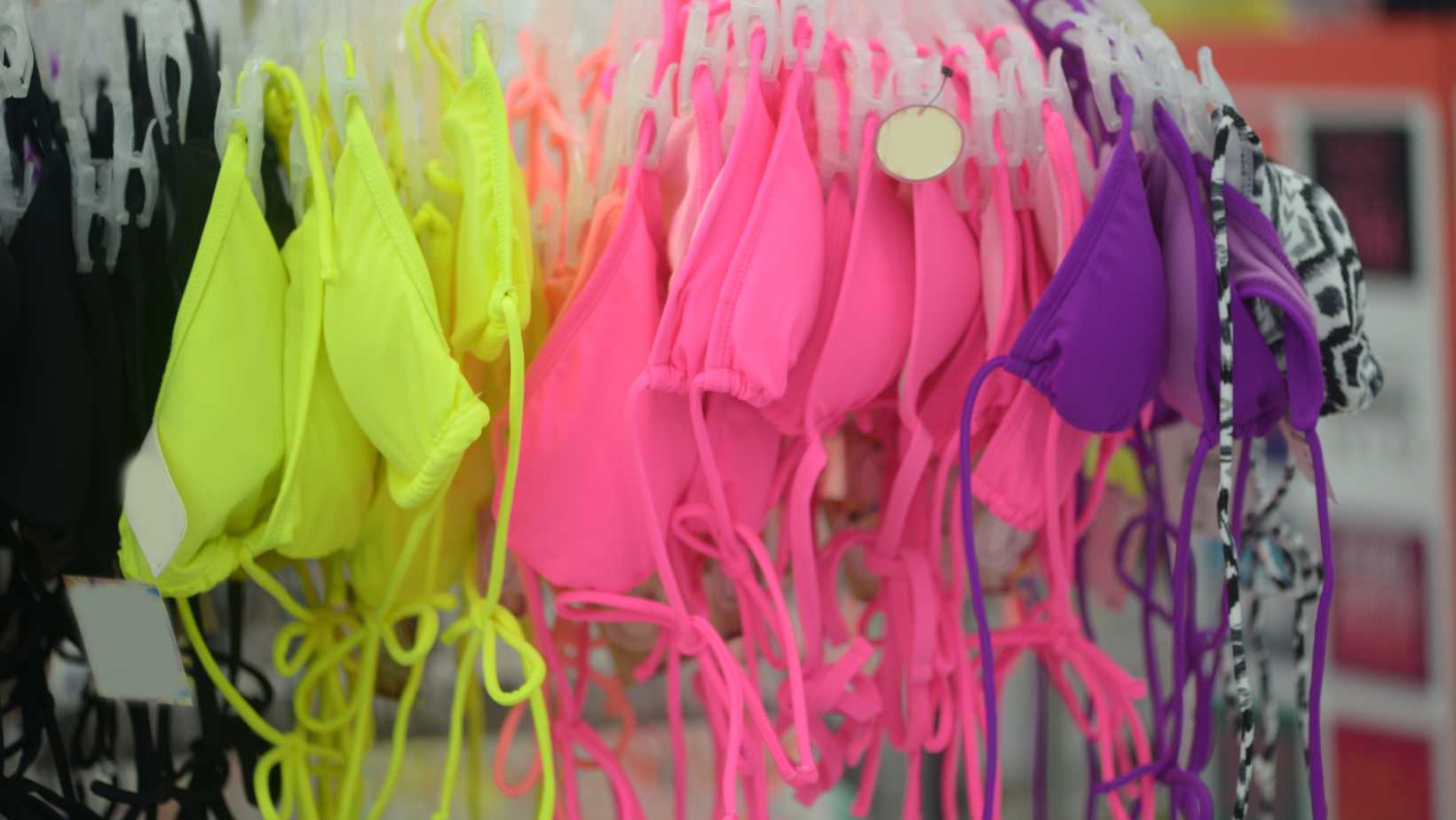Choosing The Right Fabric For Your Bathing Suit
To choose the right fabric for sewing your perfect bathing suit, dive into our guide on selecting the top swimwear fabrics. Gain expert knowledge on factors to consider before hitting the fabric store so that you feel confident and ready to select the best material for your needs. In this section, you will learn about the different types of swimwear fabrics and factors that will help you choose the perfect one.
Types Of Swimwear Fabrics
Exploring material for swimwear? Pick the right fabric for comfort and durability. Here are some options:
- Nylon – durable, quick-drying, easy-to-care-for. It can stretch up to six times its size.
- Polyester – stronger than nylon. Dries quickly and retains shape. Resists chlorine damage but fades faster.
- Spandex – stretchy material. Enhances flexibility and movement. Prevents bagging, sagging, and flattening. Adds compression support.
- Neoprene – thicker synthetic rubber. Perfect for colder water environments.
- Lycra and Carvico – for unique detailing like prints or embroidery. Both provide excellent elasticity.
Keep in mind needs like swimming style, maintenance, and comfort. Prioritize flexibility with spandex or durability with polyester. Care for swimwear routinely. Wash promptly after wear using mild detergent without bleach. Avoid dryers. Hang dry suits under shade. Choosing the right fabric is like choosing the perfect dance partner!
Factors To Consider When Choosing Fabric
When selecting a bathing suit fabric, various factors should be considered. Think comfort, durability, stretchability, breathability, sun protection, design, and texture.
For comfort, pick materials that feel good against your skin. Durable fabrics resist chlorine and fading. Stretchy ones fit the waist and hips well. Breathable ones keep you cool. UPF fabrics protect from UV rays. Design-wise, consider body type and personal taste.
Texture is also important. Smooth fabrics take less time to dry. For luxury, go for polyamide or animal prints. Stretchable fabrics are better than overly tight-fitting. Read reviews of popular brands. Also, think of modest styles and additions like lining or padding.
By taking these factors into account, you can find the perfect swimsuit: comfortable, stylish, and durable. Just remember: fabric selection is like surgery – so brace yourself for the sound of tears!
Preparing Your Pattern And Cutting Your Fabric
To prepare yourself for sewing a bathing suit, you need to focus on getting your pattern and fabric ready. With “Preparing Your Pattern and Cutting Your Fabric” as your solution, you can easily complete this important stage. The sub-sections – Choosing a Pattern, Preparing and Adjusting Your Pattern, and Cutting Your Fabric will guide you through this process seamlessly.
Choosing A Pattern
Selecting a pattern? Follow these simple steps!
- Pick one that fits your body type, skill level and personal preference.
- Check the pattern envelope for required materials.
- Compare your measurements to the chart to find your size.
- See if there are any alterations or design features you want to make.
- Inquire about the ideal fabric substitute for weight and drape.
Plus, add an inch or two when cutting out. Label each piece and where it should go in construction. You’ll soon become a pattern-pro!
Preparing And Adjusting Your Pattern
Ready to make a masterpiece? Follow these six steps to prepare and adjust your pattern:
- Review the pattern instructions for cutting layout, seam allowance and alterations.
- Trace the pattern onto tissue paper or adding paper.
- Cut the traced pattern following the size lines that best match your measurements.
- Adjust the traced pattern with additional tissue paper or added space to the seams.
- Baste stitch several parts together and try on a muslin fabric mock-up version of your garment.
- Refine any fitting issues, adjust, and then cut out the fabric pieces.
Remember to measure yourself accurately before tracing patterns. Doing this can make subsequent sewing projects much easier since adjustments won’t be needed as often.
Fun Fact: Tailors used to make garments directly from measurements taken on clients. This was a lengthy process due to wasted material when creating cutting layouts for every garment.
Now let’s get to it and cut that fabric like it owes you money!
Cutting Your Fabric
To make a project look its best, it’s important to focus on precise and accurate fabric cutting. Here’s a 6-step guide:
- Choose a sharp pair of scissors or a rotary cutter.
- Smooth out any wrinkles or bumps on fabric.
- Measure fabric with a ruler or tape measure.
- Mark pattern pieces with tailor chalk or water-soluble pencils.
- Cut along marked lines, taking care not to disturb other pieces.
- Organize cut fabrics for later steps.
Remember that capabilities vary based on the type of machine or hand sewing. With delicate fabrics prone to fraying, add zig zag seam allowances. Plaids and stripes need careful alignment during setup.
Now it’s time to sew the bathing suit – it’ll be the difference between a beach bombshell and a deflated pool float!

How To Sew A Bathing Suit
To sew your bathing suit together with the given sub-sections, you can master the art of sewing techniques for swimwear, learn how to sew up the side seams, and finally, add elastic to your bathing suit. These subsections will teach you the necessary steps required to sew together your bathing suit with ease and give you a satisfying end result.
Sewing Techniques For Swimwear
Sewing swimwear? Let’s try it! Here are 3 steps for success:
- Pick the Right Fabric – Choose something with at least 20% stretch for comfort and good fit. Lycra, spandex and nylon blends work great!
- Use Stretch Stitches – Not regular straight ones. Go for zigzag or triple spandex stitch – they look great and offer enough give for movement.
- Details Matter – Get a sharp ballpoint needle and test your machine tension. Be extra careful with elastic, straps and edges.
For extra uniqueness, add topstitching or decorative touches like beading or embroidery.
Fun Fact: In ancient Rome, swimming was a luxury. Private pools had frescoes and sculptures of mythical scenes. Romans would’ve been amazed at our modern-day swimsuit construction techniques!
Sewing Up The Side Seams
To complete your bathing suit, you need to stitch the sides together. Pin the right sides together. Start at the top or bottom and sew from one end to the other. Take out the pins as you sew. Do this on both sides. Make sure all seams are straight and secure.
However, your specific bathing suit pattern or design might be different. Use extra techniques to help the fabric edges fit together. Shorten the stitch length to prevent any seam opening. Use a serger stitch or zig zag stitching to finish raw edges. This prevents fraying over time.
But why not try something different? Duct tape holds everything together!
Adding Elastic To Your Bathing Suit
Incorporating elastic is key to reinforcing your bathing suit’s structure. It should fit comfortably, not too tight or too loose. Here are 6 steps to adding elastic:
- Set up a workspace with a table covered in parchment paper.
- Before cutting the fabric, check the pattern photo measurements.
- Cut the appropriate-length elastic with the right amount of tension.
- Sew with zigzag stitches, using a stretch needle or twin needle.
- Stitch up the blouse parts as per instructions.
- Iron out creases and trim hanging threads.
Braided or knit elastic is preferable to woven, as it has greater stretchiness. Make sure your machine has enough tension. Exercise caution when combining fabrics and when washing/cleaning afterwards. Finally, a little fraying can be a good thing, until it isn’t.
Finishing Touches
To finish your bathing suit with finesse, you need to master the art of the finishing touches. Hemming your bathing suit, attaching straps or ties, and adding embellishments to your bathing suit are the solutions for this section called “Finishing Touches” in the article “Exploring the Art of Sewing a Bathing Suit”. Let’s explore each of these subsections to give your bathing suit that extra flare.

Hemming Your Bathing Suit
To make sure your swimsuit fits perfectly, you’ll need to hem the edges. Here’s how:
- Measure the excess fabric you want to cut off.
- Mark where you’ll cut with chalk or a fabric marker.
- Carefully snip along the marked line with sharp scissors.
- Fold and pin the edge 1/4 inch, then sew it with a zigzag stitch.
Try on your suit after each step and adjust as needed.
For added flair and support, consider using swim elastic or trims.
Fun Fact: People in Ancient Greece wore garments similar to modern one-piece swimsuits!
Attaching Straps Or Ties
To secure your clothing, straps or ties are a great option. Here’s how to do it:
- Choose where to place the fastening. This may be at the back, front or side of the garment.
- Cut out straps/ties from matching fabric. Measure the length and keep the width consistent.
- Sew them into place with a machine or by hand.
- Add any optional extras for an extra bit of flair – like buttons, bows or other accessories.
With a bit of attention to durability and looks, you can create clothing that is both useful and attractive. So don’t be scared to customize your wardrobe with special fastenings! And why not add sparkle to your bathing suit this summer?
Adding Embellishments To Your Bathing Suit
Make your boring swimsuit stand out! Add some embellishments for a chic and stylish look. Here’s how:
- Pick the right material.
- Decide where to place it.
- Plan the design.
- Attach it with glue or thread.
- Get creative with sequins, rhinestones, beads, patches, ribbons, etc.
- Wait for the glue to dry.
For something one-of-a-kind, why not go for 3D floral designs with ruffles or lace? Just remember not to overdo it. Too many embellishments can ruin the shape after washing. Keep it simple and elegant for a timeless look!

















































